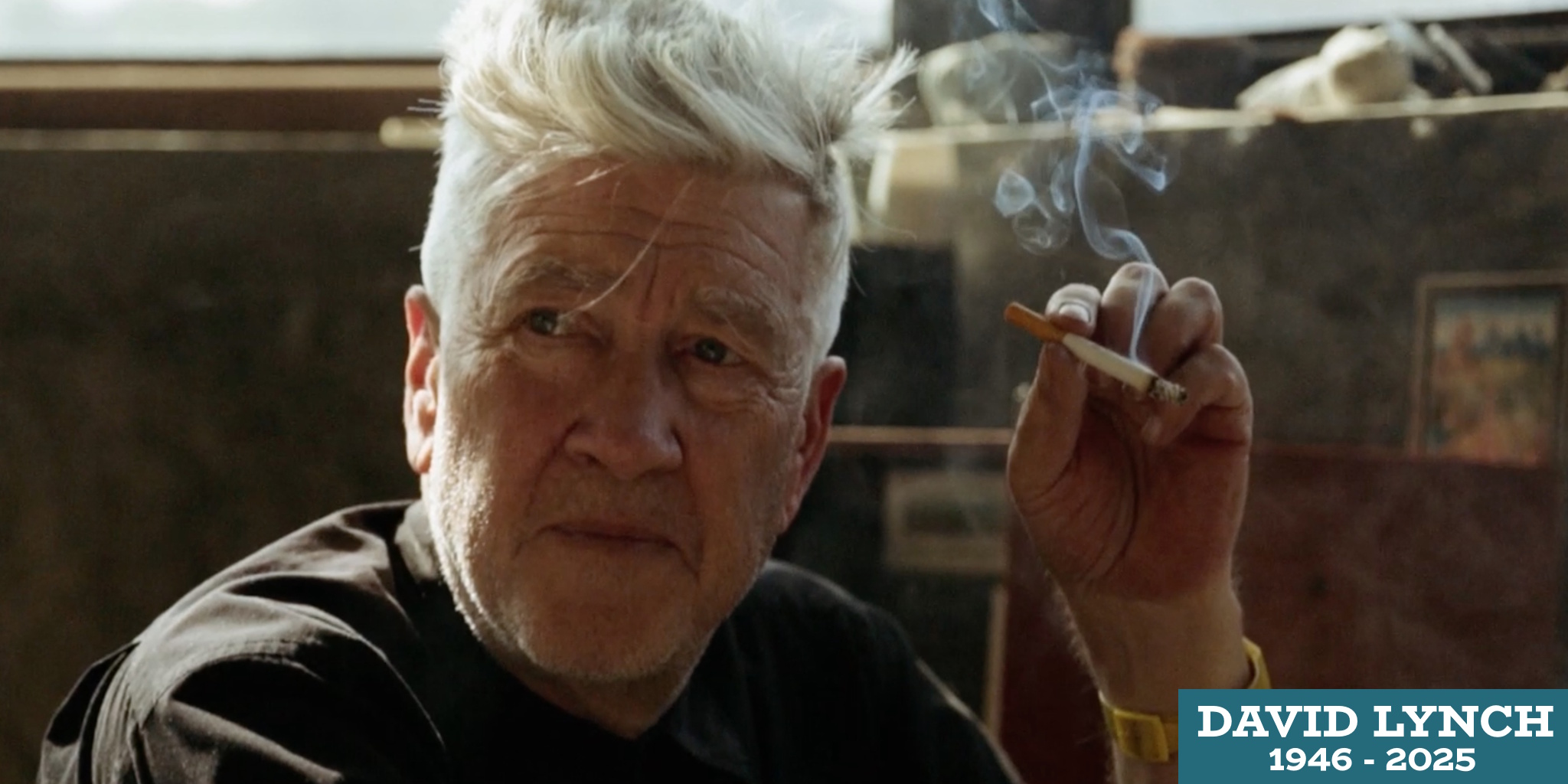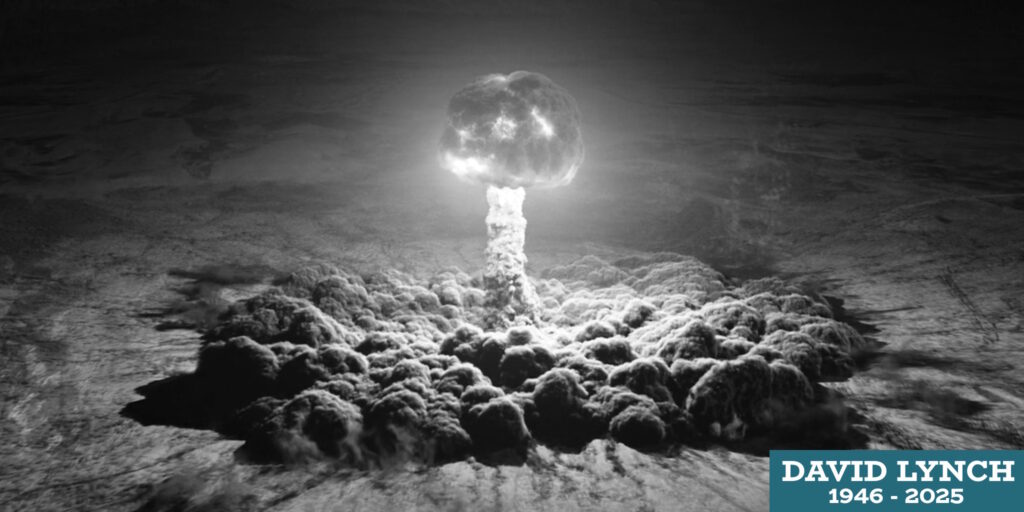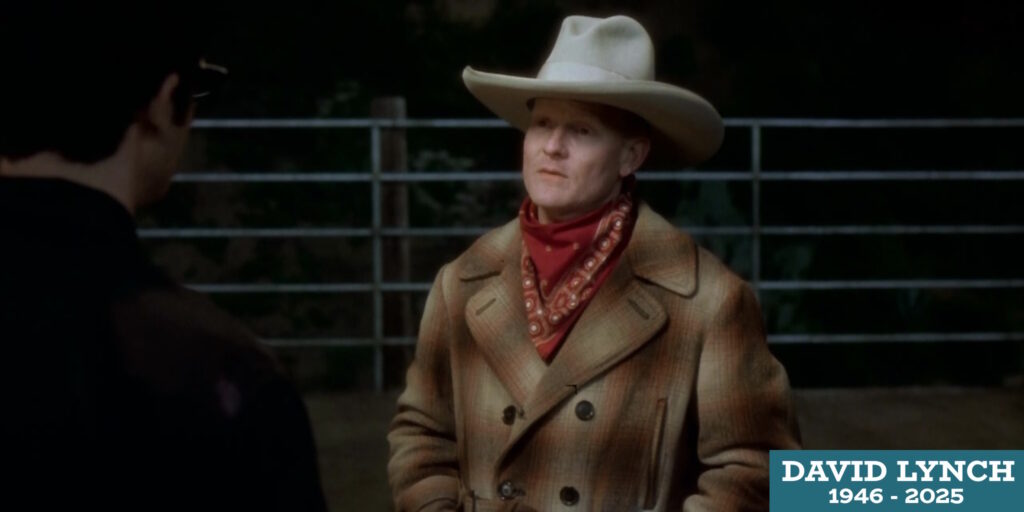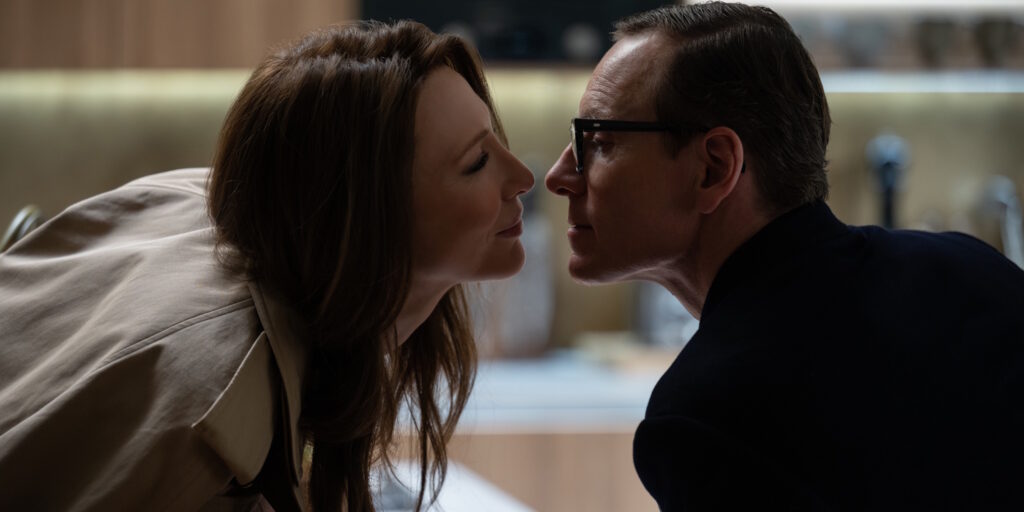Editor’s Note: It’s difficult to overstate the importance of David Keith Lynch and his works to the founders of The Take-Up. (There’s a reason that we emerged from behind the blue curtains of Club Silencio to introduce ourselves.) Accordingly, the news of his death on Jan. 15 was both gutting in the moment and profoundly sad upon reflection. However, we also feel privileged to have shared the world with such a singular and self-assured artist, who has left behind an endlessly fascinating body of work that will outlast us all. In the coming months, we will be giving Lynch his posthumous honors through a series of new and re-published works on this inimitable American artist: a true patron saint of the weird, the terrifying, and the sublime.
News of David Lynch’s death on Jan. 15 didn’t entirely surprise – he was 78, after all, and had announced last year that he was homebound because of emphysema, the result of his chronic smoking (a lifetime adjunct to his similar devotion to black coffee and cherry pie). But however prepared we were for his departure, the loss of one of cinema’s greatest and most singular talents still saddens.
My own Saul-on-the-road-to-Damascus Lynchian conversion occurred when my friend Pat Baczenas and I attended a Varsity double bill of Eraserhead and Tod Browning’s Freaks in 1979. Although Freaks – which played first – certainly disturbed, Eraserhead’s mind- and mood-altering effect on us was of an entirely different order. Retreating to Blueberry Hill after the screening, we sat in near-silence, slack-jawed and stunned, incapable of processing or intelligently discussing the film we’d just seen.
When I began reviewing films at The Riverfront Times in 1983, Lynch’s films – though maddeningly infrequent – were among those I most looked forward to seeing, and when I became an RFT editor in 1987, I greedily chose to assign them to myself rather than to one of the paper’s growing cadre of critics. As an inadequate tribute, collected below is a selection of my RFT writings on Lynch, beginning with a (then) career-spanning survey pegged to 1990’s Wild at Heart.
I should note that I have a particular fondness for the Wild at Heart article because of the circumstances of its composition. When I wrote it, I was imminently leaving for vacation, which required a substantial amount of early prep work for the next few issues of the RFT, and I was therefore scrambling to finish my piece while attending to my other duties. Although I managed to wrap up a version of the article, I was naggingly dissatisfied with the result, and as my wife, Ledy, and I drove West, I kept mulling my unhappiness and decided to make an attempt to address the essay’s deficiencies. After we set up camp in Colorado’s Great Sand Dunes, I took out a pen and legal pad and – much to Ledy’s ever-growing annoyance – began adding new material, working by lantern light in our tent as darkness descended. The next morning, though I’d managed to finish in the early hours of the morning, I still needed to send the fresh material to the RFT, and in those pre-internet days, fax was the only option. As we headed north toward our next destination, Dinosaur National Monument, I kept scouting for a store that offered a fax service, but in the remote areas we were traveling through, the pickings were dismayingly slim. Finally, in Vernal, Utah – pop. 10,000 – I spotted a furniture store that, oddly, allowed public faxing for a fee, and I managed to send the pages to my colleagues, who then had to type in my carefully hand-printed revisions and additions to the original piece. I somehow doubt they appreciated my obsessiveness, and I know Ledy found it absurd. But Lynch inspired that sort of crazed devotion in me.
In addition to the Wild at Heart piece, I’ve appended three reviews – of Blue Velvet, Twin Peaks: Fire Walk with Me, and Lost Highway. I also reviewed, negatively, Dune on its release, but given that Lynch has essentially disowned that work, I’m not including the article here. I also opted not to resuscitate a relatively brief assessment of Twin Peaks, written during the early weeks of its first season. My colleague Robert Hunt had actually reviewed the pilot for the RFT, but my enthusiasm for the series was so great that I felt compelled to add my own thoughts, couched in an overview of the changing television landscape.
Except for a few factual corrections, I’ve chosen to let these pieces stand as written at the time. As such, they speak to the hazards of producing criticism on tight deadlines and with serious space restrictions (the lengthy Wild at Heart piece excepted). Case in point: I’m pleased that I at least recognized Blue Velvet’s magnificence, but my review was cursorily inadequate because I also had to address a pair of documentaries in the same issue. Even more pertinently, in re-viewing these films over the subsequent years – particularly through the lens of a course on Lynch that I taught on two occasions at Webster University – my estimation of them has changed considerably. Although I still admire many aspects of Wild at Heart, for example, I now cringe at its streak of misogyny, especially Lula’s discomfiting excitement at Bobby Peru’s sexual depredation. By contrast, I consider both Fire Walk with Me and Lost Highway far more compelling than my original takes indicate.
In my younger days, I clearly found the ambiguities of Lynch’s work more problematic. Nowadays, I find that aspect of his films to be one of its principal attractions – like songwriter Iris DeMent, I’ve learned to “let the mystery be.”
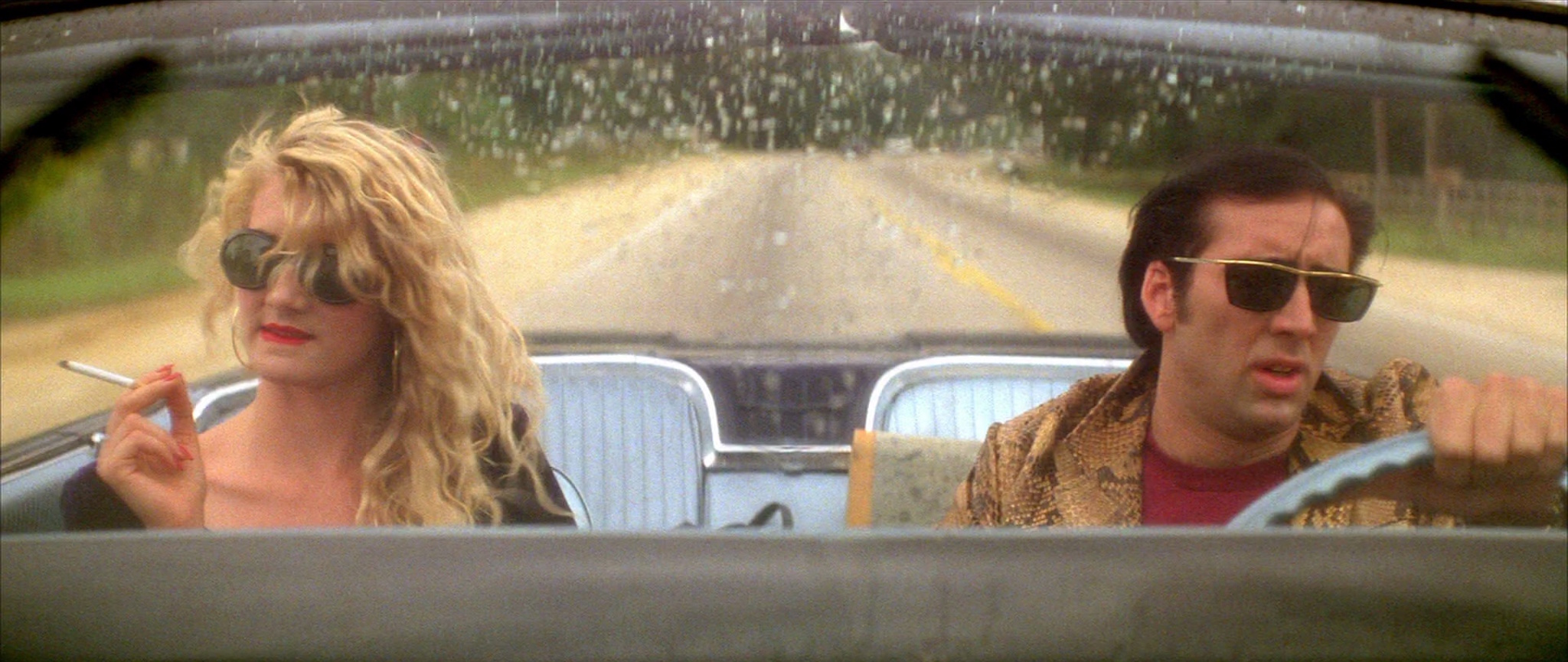
Wild at Heart (1990]
Down there – in the yawning abyss of self – is where David Lynch capers and plays: mucking joyfully about in the mind’s swampy backwaters, rolling happily in the primordial filth, burrowing curiously into the psychic landfill in search of life’s toxic byproducts.
Lynch unearths the buried secrets – the furtive wants, the embarrassing needs, the repressed desires – and hauls them up into the light for us to examine with horror, with fearful awe, with appalled fascination.
He’s the carnival barker luring us into the freak show and then showing us our distorted reflections in a funhouse mirror. He’s the pathologist dissecting the corpse, the seer poking through the entrails, the voyeur peeping through the window.
He’s the uncensored id. He’s the genuine article.
David Lynch – like Sailor and Lula and Bobby Peru, fellow travelers on his latest expedition into humanity’s dark interior – is wild at heart.
In a signature line from Lynch’s Blue Velvet (1986), the film’s golden innocent, Sandy (Laura Dern), stares bemusedly at amateur investigator Jeffrey (Kyle MacLachlan) and says, “I don’t know whether you’re a detective or a pervert.”
Lynch himself is less troubled by Jeffrey’s easy movement between Sandy’s well-lit world of order and the chaotic alien landscape in which demented bug-eyed monster Frank (Dennis Hopper) roams free of morality’s fetters. Lynch, in fact, cheerfully proposes that it’s not just Jeffrey – that both he and we also contain such dichotomies. As Lynch told a Film Comment interviewer in October 1986: “This is all the way America is to me. There’s a very innocent, naive quality to my life, and there’s horror and a sickness as well. It’s everything.”
Lynch’s own oddly boyish handsomeness and placid demeanor belie his dark obsessions. On meeting Lynch, Mel Brooks, who produced the director’s The Elephant Man, famously remarked: “I expected to meet a grotesque, a fat little German with fat stains running down his chin. Instead, there’s this clean American WASP kid, like Jimmy Stewart 35 years ago.”
And, in fact, Lynch’s early years were something of an American model: a happy family life under wide Western skies; a boyhood in white-picket-fence, green-grass, red-roses environs not dissimilar to Blue Velvet’s opening, but with none of the film’s sinister undercurrents. Born in January 1946 in Missoula, Mont., Lynch grew up in the Northwest (Idaho and Washington) – the cool, pristine setting of his TV series Twin Peaks – before moving to the South (North Carolina and Virginia), which provides the backdrop for Blue Velvet and the sordid, hothouse atmosphere for his new film, Wild at Heart.
After high school, Lynch first attended the Boston Museum School and then, in 1965, enrolled in Philadelphia’s Academy of the Fine Arts. In Jonathan Rosenbaum and J. Hoberman’s Midnight Movies, Lynch says that “he always wanted to be a painter”; filmmaking was a profession he happened on rather than consciously planned. (The critical success of his films, ironically, has revivified his art career, and a book of his paintings is due shortly.)
Although Lynch remained in Philadelphia for five years, the city needn’t consider him for future tourism campaigns: “We lived in a real bad area of Philadelphia,” Lynch once recalled to writer Gary Indiana, adding, “All of Philadelphia is a bad area, really…. There was racial tension and just … violence and fear.” That “violence and fear,” and the city’s blighted industrial landscape, would eventually manifest themselves, albeit in an aesthetically transformed fashion, in Lynch’s first major film, Eraserhead.
However, before making Eraserhead, a process that would sprawl over five years, Lynch shot a number of provocative shorts. The first, exhibited in ’66, was more art object than film: a 1-minute continuous loop shown on a sculptured screen on which three human-shaped torsos protruded. According to Rosenbaum, “the major event depicted was six people getting sick together.” In 1967, Lynch was commissioned to make another of his “film-paintings” for a patron. The project eventually evolved into the 4-minute film “The Alphabet,” which Lynch described in a 1984 Cinefantastique article as “a little nightmare about the fear connected with learning. It’s very abstract – a pretty dense little film.” On the strength of “The Alphabet,” Lynch received an American Film Institute (AFI) grant for “The Grandmother,” an ambitious 34-minute short without dialogue about a lonely boy who grows a grandmother from a seed that he plants and nurtures in a mound of dirt in the attic.
These early shorts – with their dream-state logic and associative imagery, their obsession with natural and unnatural biological processes, their emphasis on the visual (and visceral) over the verbal (and intellectual), their evocations of alienation and fear – were precursors to Lynch’s features, in both content and form.
The first of his longer works, Eraserhead, serves as the blueprint on which Lynch continues to base his singularly designed filmic structures – those Gaudi-like cathedrals, all phallic spires and curves and organic textures, that contrast so sharply with Hollywood’s blandly rectangular skyscrapers of concrete, steel, and reflective glass.
Not an easy film to synopsize – particularly since its hypnotic power flows not from its highly discursive, unconventional narrative but from its distinctive, otherworldly vision – Eraserhead deals with entrapment and powerlessness, with its anomic hero Henry’s inability to break free of the convergent forces – emotional (his girlfriend Mary X, the Beautiful Girl Across the Hall), biological (his grotesquely deformed “baby”), and mechanical (the Man in the Planet) – that keep him inert. Shot in expressionistic black-and-white against an anonymous decaying cityscape (actually stables and garages at the AFI’s Centre for Advanced Film Studies in Hollywood), the film evokes a specifically urban dread, and an ominous industrial drone echoes throughout. However, Eraserhead’s expression of existential despair and the attendant yearning for a real or imagined escape to freedom are universal.
A staple of the midnight-movie circuit throughout the late ’70s/early ’80s, Eraserhead shares with other cult films of the era an undeniable, even definitive, “weirdness,” but it has none of their campy self-consciousness or deliberately outrageous behavior or ersatz psychedelic trips. Eraserhead is funny (in its uniquely morbid, queasy way), profoundly revolting, and hallucinatory, but it doesn’t poke snide fun or merely gross out: It disturbs. An Eraserhead audience displays none of the communal high-spiritness of a typical movie cult; an eerie, disquieting hush is far more typical.
Eraserhead is frequently discussed in relation to the films of Lynch contemporary John Waters (Pink Flamingos, Desperate Living), whose pre-Hairspray work is similarly outré and shocking. But Lynch, in his ’86 Film Comment interview, was canny and self-aware enough to identify the significant differences in the directors’ equally skewed worldviews: “His (Waters’) way is making so much fun of those banal, absurd, polyester things. I want to come at them sideways in a drier way, for that certain kind of humor. And also so that you can slip into fear.”
Take note of that late addition: “And also so that you can slip into fear.” Lynch isn’t interested in breaking taboos for the sake of gasps and ain’t-that-disgusting titters; the intent is to descend into the maw of horror, to confront the primal terrors, and to emerge with both new understanding and renewed hope.
None of this is necessarily articulated in clear, precise terms in Lynch’s films – they have elusive, multiple meanings, intentionally vague themes, and few uplifting “messages,” at least of the traditional, socially conscious, and responsible variety. Eraserhead is the most extreme (some would say purest) example of Lynch’s bias toward image-based filmmaking, but all of his movies have the same surreal, pre-verbal feel. Sound is important, and music – since we respond to both more in an emotional than intellectual fashion – but words are almost incidental, inadequate, and unable to properly analyze the world’s neuroses, capture its beauties, or solve its mysteries. Lynch resists explanations, as the open ending of Twin Peaks proves: It’s the journey of discovery, not the destination, that interests him.
Lynch’s most uncharacteristic and least compelling film, Dune (1984), collapsed precisely because the director was forced to carry too heavy of an expository burden; the movie’s alternate worlds, particularly (and predictably) the dark planet Harkonnen and its repellant inhabitants, are stunningly realized, but the complex story is nearly incomprehensible. Lynch acknowledged the film’s problems in a 1987 Sight and Sound interview and wistfully talked of re-editing Dune to conform more closely to his sensibilities: “I would like to make it more like a long poem,” he said, “just let it be abstract in some places, with no dialogue, and let it be more of a mood.” (However, the long, 190-minute TV version of Dune, with its added footage, is not Lynch’s director’s cut; he’s disavowed this version of Dune, and it’s credited to the pseudonymous Allen Smithee.)
At his best, then, Lynch is allusive rather than descriptive; he’s less a teller of stories than a maker of discomfiting images, of haunting sounds. In Midnight Movies, he posited that this trait stems from his background in the visual arts: “When you’re a painter, you don’t think on the surface, so you don’t ever have to articulate these things to somebody. They’re just allowed to kinda swim…. It’s all feelings: it feels right and you know instinctively what it’s all doing, and you work from that level. It just somehow turns into being an honest thing if you stay on that level, and just let these ideas swim around, down where you capture them.” Angling as he does in the oceanic crevices of the unconscious, Lynch’s ideas have the luminescence and grotesque, mutated beauty of deep-dwelling fish: seemingly monstrous counterparts to the familiar creatures that live in shallower waters.
That contrast, or rather that complementary relationship, is Lynch’s repeated motif – the major musical theme on which he plays fantastic variations. In The Elephant Man (1980), for example – a film on which he essentially served as director-for-hire – Lynch shows the delicate sensitivity, the beautiful soul, within John Merrick’s ugly, disfigured body; in Blue Velvet, a far more personal film, he reverses the equation, hinting at the enormous capacity for evil that exists within the handsome, sweet-natured Jeffrey.
The occasional dissonance of Lynch’s improvisations, their frightening abandon, distresses those who require a note-for-note interpretation, who want soothing harmony. But Lynch claims the wild sounds are found in the music: “I understand when people say that things in the films are strange and grotesque,” he told American Film in December 1984, “but our world is strange and grotesque, right? They say truth is stranger than fiction. All these strange things in the films are triggered by this world, so it can’t be all that strange. I love things that are absurd. It’s really real to me.”
Lynch exaggerates a bit: Any truth, however bizarre, is certainly less strange than the demented fiction of Wild at Heart – a film that itself delights in excess, overstatement, and grand, histrionic gestures. The movie – equal parts Gothic melodrama, deadpan black comedy, and couple-on-the-run film noir – is a steaming, hissing potboiler all a-bubble with impulsive acts, kinky sexual hijinks, and blood-spurting, stomach-churning violence. Like a hot jazz band, it cooks, upping the intensity of the ever-mounting flame.
Sailor Ripley (Nicolas Cage) and Lula Pace Fortune (Laura Dern), the young lovers who generate much of Wild at Heart’s heat, are typically Lynchian: essentially naive, even strangely innocent, but burning with passion, prone to unpredictable emotions, from melancholia to unbridled rage. With his top-down Caddy and snakeskin jacket – “a symbol,” he hilariously declaims, “of his individuality and belief in personal freedom” – Sailor is both figure of romance and flouter of convention: a true believer, an eternal lover. Lula, too, is proudly defiant, and when Mama Marietta (Diane Ladd) forbids her daughter’s romance after Sailor’s rejection of some more-than-motherly affections, good Southern girl Lula stands by her man. And chivalrous Sail – even after he’s physically attacked and jailed for his affront to Mama’s dignity – stays mum about Marietta’s sexual advances for fear of hurting his darling Lula.
Wild at Heart’s story proper begins after Sailor’s prison release, as he and Lula – over Marietta’s banshee wails of objection – light out from Cape Fear, N.C., for the promised land of California. Dogged by Marrietta’s emissaries – detective Johnnie Farragut (Harry Dean Stanton) and the criminal minions of gangster Marcello Santos (J.E. Freeman) – Sail and Lula motor through New Orleans and on to Big Tuna, Texas, where their already limited money and luck plumb run out. At a seedy motel where malignant locals eye them balefully, the couple encounters Bobby Peru (Willem Dafoe), a Mephistophelean figure who promises redemption but delivers them to perdition.
Although anchored by the plot of Barry Gifford’s source novel, Lynch’s Wild at Heart is tethered on an extremely long line and drifts easily into uncharted waters. Filled with brief glimpses of distorted or fragmentary remembrances, tangential stories, memorably quirky cameos, spooky encounters, larkish fantasy, and random scenes of horror, the film flows down a roiling stream of consciousness with wicked curves and treacherous rapids. A few of these bits of incidental business and stray recollections – e.g., of Lula’s psychotic cousin Dell, played with typically spastic unpredictability by Crispin Glover – are dead-end excursions down creepily still and brackish tributaries of the main story. The film, in fact, tends to meander too much and too often, and there’s the occasional sense that it’s sailed dramatically and irreversibly off course, that Lynch has lost all direction and control.
Wild at Heart’s movement toward entropy, however, is a reflection of Lynch’s view of life as essentially chaotic, pregnant with unforeseen disaster. The film’s literal journey – its voyage of the damned – is thus a metaphorical search for safe harbor, for shelter from the absurdist storm. And, as Sailor realizes at the movie’s over-the-top, swooningly romantic finale, the world’s only true source of order – the one thing that makes a degree of sense – is love. Like Dorothy in The Wizard of Oz – a work to which Wild at Heart makes constant and playful, but significant, reference – Sailor and Lula long only for a return to their home in each other’s arms. It’s a crazily optimistic concluding message from an otherwise bleakly pessimistic film, but that’s Lynch: Just as upstanding citizen Jeffrey of Blue Velvet finds evil irresistibly intoxicating, rebellious bad boy Sailor and bad girl Lula are, at heart, not only wild but good – their love causes death but also yields life.
Cage, as Sailor, beautifully embodies both this dichotomy and Lynch’s expressionistic sensibility. In more naturalistic films – Peggy Sue Got Married is the most egregious example – Cage’s presence can be disconcerting, his cartoonish, outsized performances at unsettling odds with the quieter, realistically shaded work of his fellow actors. But in movies whose stylistic approach is as extreme as Cage’s – such as Raising Arizona, Moonstruck, or, especially, Wild at Heart – he is at once hilarious, frightening, and magnetically attractive. Here, Cage’s Elvis-imitation affectations thus are less an actor’s attempt at easy humor – though he is funny – than an accurate depiction of the character’s peculiar obsessions: The romanticism inherent in Elvis’ songs, delivery, and manner is also an important component of Sailor’s own expansive, bigger-than-life personality. Apparently a liberating experience for everyone concerned, Wild at Heart allows – or, more exactly, encourages – not just Cage but all its performers to take off realism’s governor, and Dafoe, Dern, Ladd et al. gleefully respond, pushing hard at the pedal and accelerating into unbraked stylization.
The mad ride of Wild at Heart exhilarates the audience as well as its actors, but the film provides more than the safe roller-coaster thrills of Hollywood’s usual amusement-park contraptions. Wild at Heart plumbs wells of real fear; its violence profoundly shocks. David Lynch’s Wild at Heart is a work of terrifying surrealism: a fever dream of a film by an all-American Buñuel.
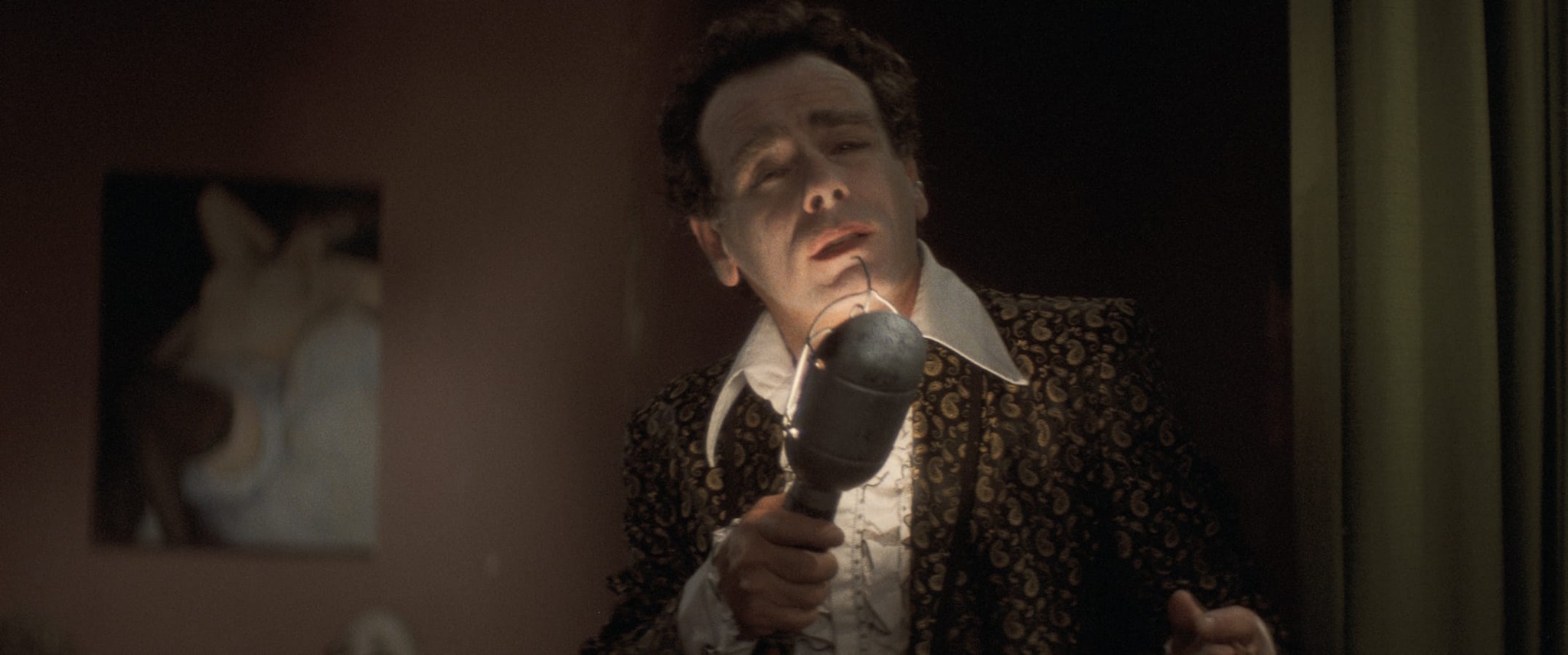
Blue Velvet (1986)
The thematic message of Blue Velvet is the intuitive apprehension of a precocious adolescent: Corruption and putrefaction lie in shallow graves beneath the world’s illusorily attractive surface. In the intentionally banal terms of its naive hero, the film concludes simply, albeit with an ironic smile, that “life is strange.” If that superficial “insight” were all it offered, Blue Velvet would be an insignificant, laughably pretentious thriller, but the surreal vividness with which director David Lynch illustrates this hackneyed conceit lends it renewed vigor and profundity, a weirdly seductive force.
Lynch’s intent is not to teach – and certainly not to moralize – but to transport: Appealing more to id than intellect, Blue Velvet hypnotically explores·the unconscious. Although the film’s B-movie mystery plot supplies genre hook and narrative line, it quickly becomes apparent that the solution to Blue Velvet’s puzzle is mere red herring: The fish for which Lynch is angling swims in the mind’s most treacherous depths.
As amateur detective Jeffrey (Kyle MacLachlan), surrogate for both director and audience, plumbs the mystery’s lightless recesses, he thus simultaneously probes the darkness within, discovering his own black secrets. Pulled between the light (Laura Dern’s flaxen-haired girl-next-door Sandy) and the dark (Isabella Rossellini’s sloe-eyed fallen woman Dorothy), Jeffrey sees his own capacity for evil reflected and magnified in Frank (Dennis Hopper), the demonic force of nature whose ill wind sweeps through and disturbs the tranquil calm of Lumberton.
Expressing his ideas visually rather than verbally – his dialogue alternates hilariously between deadpan understatement and overwrought emotionalism – Lynch transfixes our attention with the rich, otherworldly imagery of his fecund imagination. Teeming with underground life, Blue Velvet, a profoundly disturbing masterpiece, speaks directly to the corruption within us all.
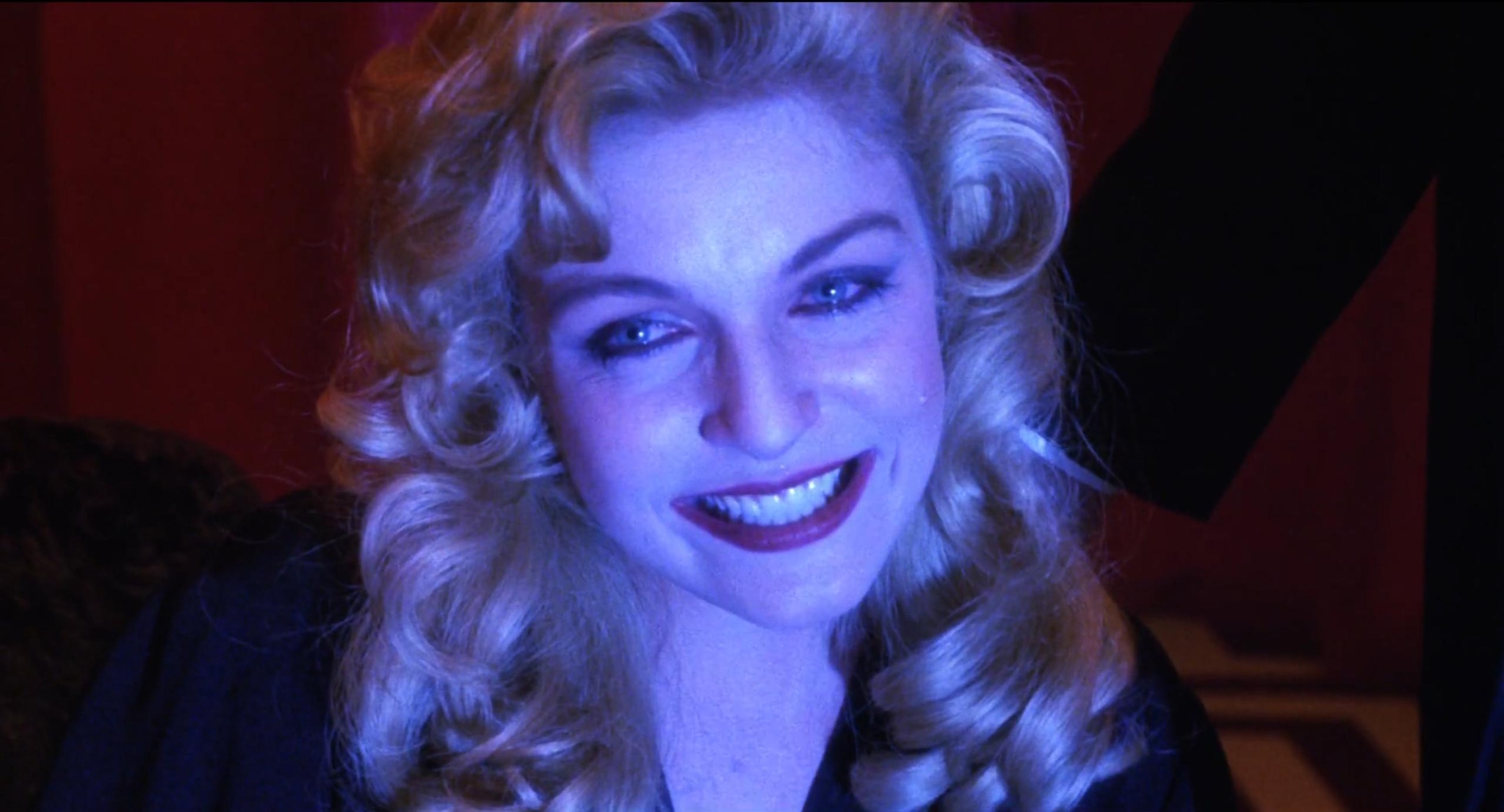
Twin Peaks: Fire Walk with Me (1992)
There’s a disappointing redundancy to Twin Peaks: Fire Walk with Me, a been-there-done-that emptiness that results from one too many trips through the funhouse: We’ve already walked that creepily spongy floor, gazed in those distorting mirrors, shuddered in the sudden and mysterious darkness, jumped and screamed and laughed with nervous delight but real fear at the artificial horrors.
Especially in the generally banal context of television, Twin Peaks’ glorious eccentricities – the offhand surrealism, quirky humor, elliptical imagery, perversely languorous pacing, deeply heartfelt romanticism, and extreme, mercurial, and profoundly disturbing narrative – gave the narcotized mass audience a bracing shock, its nightmarish intensity shaking us awake in the midst of our blackest, most frightening dreams. Reimagining aspects of the story for the big screen, director David Lynch naturally makes explicit the integral elements of sex and violence that could only be implied on network TV – though, contrary to some hyperbolic reports, the film remains relatively restrained – but that still doesn’t free him from the more important constraint of our foreknowledge, our intimate familiarity with the Twin Peaks’ cast, milieu, and plot (however complicated and maddeningly inconclusive). Without that information, of course, Fire Walk with Me would likely prove hopelessly confusing and utterly lacking in emotional resonance, but with it, we can’t help but feel jaded and slightly dissatisfied by its lack of invention, its reliance on old conceits. Much of the appeal of Twin Peaks the TV series was its freshness; by contrast, the paradoxical attraction of and problem with Fire Walk with Me is its conscious effort to give us exactly what we expect. Seeing these characters again and hearing that evocative score, a weird sense of nostalgia envelops us: We’re oddly comforted, despite the story’s determined intent to disquiet.
If Lynch had chosen to extend the Twin Peaks storyline, to pick up the dozens of dangling plot threads and tie at least a few of them together, these criticisms would have perhaps been less pertinent, for new information would have by necessity been incorporated. In taking that course, however, the filmmakers would have limited their potential audience to committed Twin Peaks fans. Fire Walk with Me, as a “prequel” to the series, has a form of narrative closure – the death of Laura Palmer (Sheryl Lee) and the revelation of her killer – and thus doesn’t technically require any prior acquaintance with Twin Peaks. However, as a faithful viewer of the series – even after it had lost its hip cachet in the deliberately off-putting and admittedly erratic second season – I can only imagine the helpless bewilderment of a Twin Peaks virgin encountering Fire Walk with Me without at least a facts-of-life lecture. So why bother courting those you’re fated to alienate? Why not move forward rather than backward with the characters and narrative? (The film’s most successful moments, in fact, occur during a long introductory sequence featuring an almost entirely different cast – Chris Isaak, Kiefer Sutherland, Harry Dean Stanton – and a new if related story.)
Lynch would no doubt claim that the “prequel” aspect of Fire Walk with Me was not dictated solely by commercial considerations. In the film’s press kit, he says simply of Twin Peaks, “I had to go back in,” and there is an undeniable attraction to filling out Laura’s sketchily drawn character, to explaining her motivations and clarifying the murky details of her murder. Regrettably, Fire Walk with Me never entirely accomplishes any of those admirable goals: The mysteries of the famous Red Room remain inherently insoluble, and although Laura is rendered more complex and pitiable, the psychological root of her self-destructive behavior – sexual abuse by her father, Leland (Ray Wise) – is both obvious and revealed far too early, thus diminishing its horror and undercutting any potential suspense. (And, again, those familiar with Twin Peaks have already made this “discovery,” albeit in a more oblique but no less terrifying fashion.)
Eliciting a curious mixture of frustration and guilty pleasure – we, too, want to “go back in” – Twin Peaks: Fire Walk with Me ultimately serves as an appendix to the series: a welcome supplement to the text that offers interesting but not-quite-vital information.
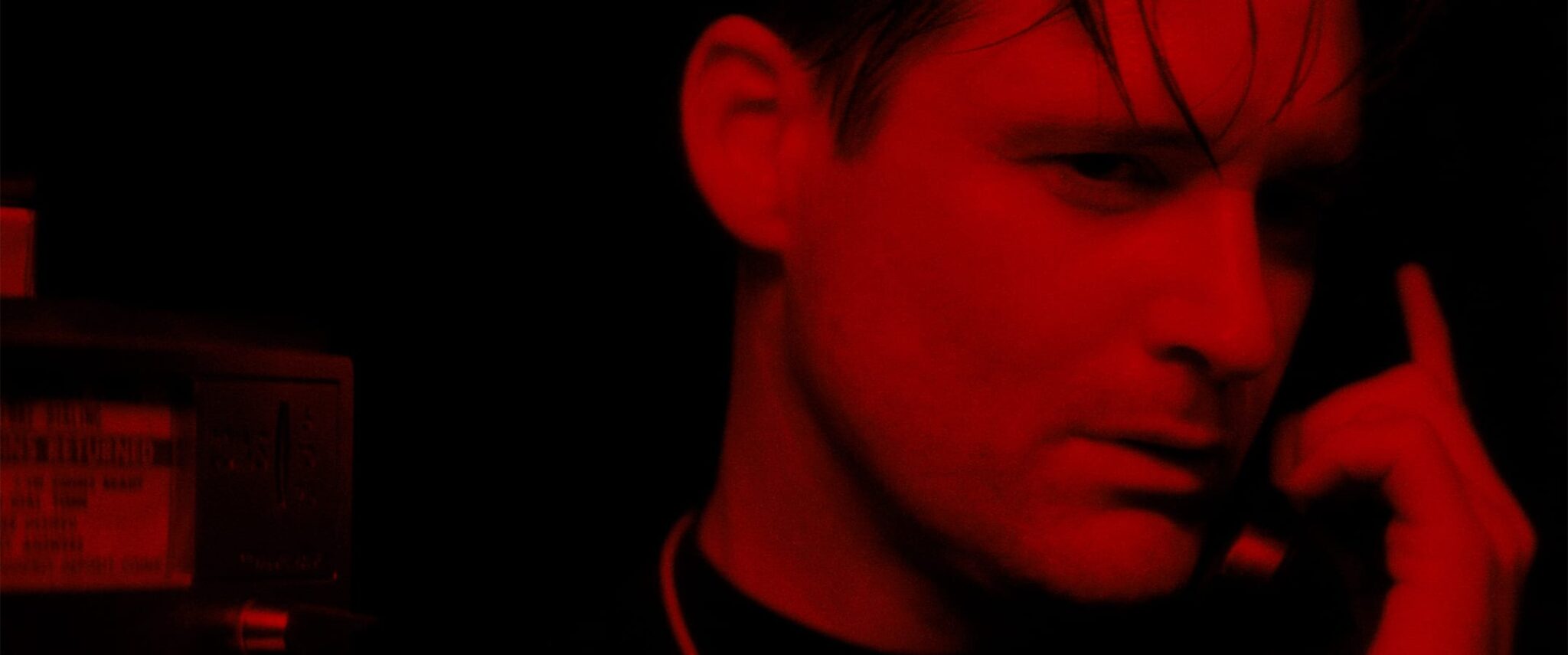
Lost Highway (1997)
The mere arrival of Lost Highway after David Lynch’s extended absence from the screen is sure to excite the filmmaker’s devotees – and I count myself among their twisted number – but the movie itself, although hugely pregnant with apparent meaning and portent, largely fails to deliver: lt’s just a long, messy labor. Lynchians, of course, expect and even demand a certain narrative opacity – mysterious, deliberately unexplained goings-on, almost always of a sordid, unsettling nature – but Lost Highway’s plot is so murkily impenetrable you’re likely to get tense and headachy from squinting through the story’s fog.
Although hard-core acolytes prefer the purity of Eraserhead’s nightmarish abstractions, Lynch is at his most effective when he grounds his dreamlike content in more familiar forms – the biopic (Elephant Man), the Hitchcockian thriller (Blue Velvet), the road movie (Wild at Heart), the murder mystery-cum-soap opera (Twin Peaks’ first season) – because the genre conventions, even when they’re subverted, help anchor the director’s highly idiosyncratic characters and imagery in a shared (if admittedly constructed and artificial) reality. Lynch, however, seems intent on returning to his own insular world of the elliptical and surreal: Witness the perverse joy he appeared to take in frustrating viewer expectations in Twin Peaks‘ maddening second season (e.g., the initially amusing, then agonizingly elongated scene between the creakily ancient bellhop – “I know you” – and the wounded Agent Cooper in the Lynch-directed first episode of that year) and in Fire Walk with Me, the Twin Peaks prequel, with its red-herring opening and general incoherence. Lost Highway takes him a few more miles down that rough, unfinished road: Its story is utterly inexplicable, full of weird, unresolved enigmas, and refuses to yield to traditional thematic interpretation. Answering the question “What’s it about?” has seldom been more difficult.
It’s not that the story is especially complex but that it progresses in circular rather than linear fashion. The tense, unhappy, sexually frustrated life that jazz saxophonist Fred Madison (Bill Pullman) and wife Renee (a brunette Patricia Arquette) live together – he’s afraid she’s cheating on him – becomes further stressed by the daily arrival of unmarked videotapes that become increasingly intimate in their chronicling of the couple’s activities. Who’s sending the tapes, how does the intruder gain access, and what do they signify? Fred’s unease is upped still more by a party encounter with a sinister, powder-white homunculus (Robert Blake) – identified only as the Mystery Man in the credits – who insists he knows Fred (as if you’d forget that face) and who appears to possess the nifty but disturbing power, which he demonstrates telephonically, to be two places at once. Whoa.
When Fred awakens the morning after his Mystery Man interaction, he inserts a freshly arrived videotape into the VCR and discovers that it records his bloody murder of Renee. With alarming speed, he’s arrested, convicted, and whisked away to solitary, where he clutches his head in what we at first interpret as understandable dismay but in fact proves something far more painful and weird: Fred, it seems, is mutating into something no longer Fred. Thus, when the guards swing open his cell door the next day, they find in his stead Pete Dayton (Balthazar Getty), an auto mechanic with no discernible relationship to Fred. The puzzled prison officials release the equally mystified Pete, who soon returns to work, where his key job is attending to the cars of persnickety Mr. Eddy (Robert Loggia), a gangster with a frighteningly volatile temper (hilariously illustrated by a scene – well worth the price of admission – in which he takes a hapless motorist to task for tailgating). Accompanying Mr. Eddy on one of his garage visits is mistress Alice (a blond Patricia Arquette), and when she claps wide, hungry eyes on Pete, we know someone’s going to get devoured. Much more transpires – sex, threats, sex, robbery, sex, murder – but once Alice enters (or re-enters) the picture, Lost Highway heads in a fairly predictable direction.
So: Is Pete Fred? Is Alice Renee? Although Lynch and co-writer Barry Gifford – who collaborated more successfully on Wild at Heart – eventually loop back to the story’s beginning, tying a Mobius-strip ribbon on their gaudy package, they never provide any real answers. Lynch apologists will mount persuasive arguments that such evasions constitute blows against narrative storytelling’s conservative hegemony: “Things don’t have to make literal sense,” they say. “Not everything must (or should) be explained. Exploring the mystery is more important and vital than solving it.” Well, OK. But even giving those folks their props, I have a Freudian bias toward seeing meaning emerge from even the most mystifying of dreams, and Lost Highway doesn’t parse very easily. The issue is obviously identity and its malleability: All four (or five or six) key characters – Fred/Pete, Renee/Alice, the corporeally bifurcated Mystery Man, and Mr. Eddy (who’s also known as Dick Laurent) – represent different takes on this concept. But what’s being said? That we, in Whitmanesque fashion, contain multitudes? That no one is as he or she seems? That we possess dark sides unknown even to ourselves? Who the hell knows. Lost Highway is a blank screen on which we can project any number of possible interpretations, none more valid or substantial than the other. It doesn’t say anything; you can’t argue or agree with it because it never makes a point.
Which doesn’t mean you shouldn’t go. Lost Highway still features Lynch’s trademarks: the creeping unease, the lush sensuousness, the absurdist humor (the blandly profane and inexpressive cops are especially funny). But if the ride’s sometimes exhilarating and the scenery beautiful, Lost Highway ultimately leads nowhere.
